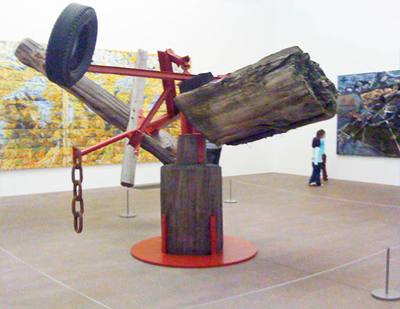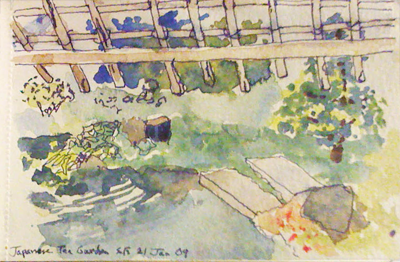We spent a couple of interesting days in San Francisco last week, and I experienced two odd coincidences linking my writing with museums…
Yesterday we went out to Golden Gate Park and walked through the Japanese Tea Garden. Had a pot of tea and sketched a splashy watercolor (see left) in a little Moleskine notebook I carry for quickies.
We had lunch at the de Young art museum, and went in to view various things, primitive and modern. Some striking—but none more so than a clunky assemblage that seems to come straight from my novella “For White Hill.” Here’s the description in the story—
Inspiration is where you find it. We’d played with an orrery in the museum in Rome, a miniature solar system that had been built of clockwork centuries before the Information Age. There was a wistful, humorous, kind of comfort in its jerky regularity.
My mental processes always turn things inside out. Find the terror and hopelessness in that comfort. I had in mind a massive but delicately balanced assemblage that would be viewed by small groups; their presence would cause it to teeter and turn ponderously. It would seem both fragile and huge (though of course the fragility would be an illusion), like the ecosystem that the Fwndyri so abruptly destroyed.
The assemblage would be mounted in such a way that it would seem always in danger of toppling off its base, but hidden weights would make that impossible. The sound of the rolling weights ought to produce a nice anxiety. Whenever a part tapped the floor, the tap would be amplified into a hollow boom.
If the viewers stood absolutely still, it would swing to a halt. As they left, they would disturb it again. I hoped it would disturb them as well.
The large technical problem was measuring the distribution of mass in each of my motley pieces. That would have been easy at home; I could rent a magnetic resonance densitometer to map their insides. There was no such thing on this planet (so rich in things I had no use for!), so I had to make do with a pair of robots and a knife edge. And then start hollowing the pieces out asymmetrically, so that once set in motion, the assemblage would tend to rotate.
I had a large number of rocks and artifacts to choose from, and was tempted to use no unifying principle at all, other than the unstable balance of the thing. Boulders and pieces of old statues and fossil machinery. The models I made of such a random collection were ambiguous, though. It was hard to tell whether they would look ominous or ludicrous, built to scale. A symbol of helplessness before an implacable enemy? Or a lurching, crashing junkpile. I decided to take a reasonably conservative approach, dignity rather than daring. After all, the audience would be Earthlings and, if the planet survived, tourists with more money than sophistication. Not my usual jury.
I was able to scavenge twenty long bars of shiny black monofiber, which would be the spokes of my irregular wheel. That would give it some unity of composition: make a cross with four similar chunks of granite at the ordinal points, and a larger chunk at the center. Then build up a web inside, monofiber lines linking bits of this and that.
And here’s the assemblage . . .

The next day in California, after the De Young Art Museum, I had another deja-something coincidence between my writing and an exhibit. In the morning, working on the current novel Starbound, I’d written a scene where the protagonist, a xenobiologist, is musing about the design of an alien spacecraft, which appears to be organic. She says:
I went back to my work station and studied the pictures of the ship, thinking of it in terms of a living organism. I’d studied terran invertebrates, of course, and remembered a seven-legged starfish. I clicked around and found the one I remembered, a pretty British creature, nicely symmetrical and less than a foot wide. There was also one from New Zealand waters, almost a yard wide, that looked octopoid and menacing, and in fact a footnote warned that if it grabbed your wetsuit it was almost impossible to pry loose. But it was the slender British one, Luidia ciliaris, that resembled the starship.
Well, I finished the morning’s writing and we took off for the California Academy of Sciences, in its new eco-sensitive building. Got our tickets and watched the penguins being fed by pretty girls in Kevlar suits (I guess penguins can be pretty rough customers), and then went downstairs to the Aquarium section, where they were about to do a coral reef diving demonstration.
Killing time before the demonstration, we went over to the touchy-feely table, where under a foot of water they have various aquatic denizens that can be touched or carefully picked up.
Right there staring at me was a bright yellow Luidia ciliaris. I picked it up and it didn’t send me any telepathic message, though under the circumstances it wouldn’t have surprised me. You have discovered our ruse, puny Earthling. Prepare to die!
Everything after that was kind of a let-down. The coral reef show was dumbed down to rug-rat level, but the dozens of small aquaria with displays of sea creatures were interesting. The leafy seahorse and weedy seahorse were worth the price of admission, ma Nature showing off how weird she can get.
The museum was airy and well-designed, but made me a little uncomfortable, because it was so little like a museum. I’d rather have one crowded with specimens, with less slick cyberstuff.
The rain forest display was interesting, a spiraling ramp that moved you up through forty feet of changing biome. But the planetarium screwed the stellar pooch. They used to have a pretty nice, not-too-modern conventional planetarium with a projector under a dome (I gave a talk there about ten years ago); now it’s just a big IMAX style theater with lots of hokey sfx but no feeling of being under the sky.
After the show we went up to the “living roof,” which was interesting. The roof is covered with no-maintenance local flora and dozens of skylights. Here’s a picture of Gay in front of it.

Several good places to eat inside the museum (remember when…oh, never mind). Went through a cafeteria line with all kinds of exotic stuff, winding up with a Vietnamese ham & shrimp spring roll and a microbrew beer.
Then we took a combination of subway, cable car, and trolley to get to the piers. Gay wanted to show me Pier 39, where sea lions have been hanging out for some years. The place encourages and protects them now, and they’re a major attraction. Big funny-looking things that yawp at each other and roll into the water every now and then.
We strolled around the touristy area. Got a nice crabmeat snack and had a sampler of three Cabernets at a wine bar. Then back to the hotel for an hour’s rest before dinner with Bob Silverberg and Karen Haber.
The Indian restaurant they’d wanted to go to was closed, so we went down to the neighborhood and found a new one that Bob was interested in. It turned out to be excellent, the food hot enough for both Bob and a normal person like me. (Bob’s tolerance for hot food is legendary; if he doesn’t complain about it being too wimpy, it’s probably toxic to mere humans.) Spent all the next day, Friday, in planes and airports. I read Lawrence Block’s Ticket to the Boneyard, which was an okay Matthew Scudder novel. The AA stuff gets repetitive to me, and the unstoppable monstrous killer was a little too implacably competent. But both seem to be de rigeur for the subgenre.










